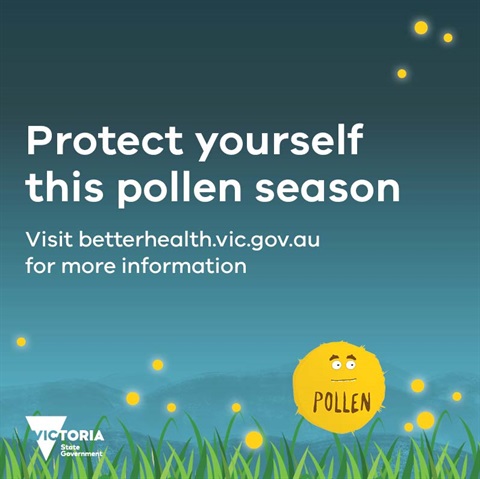Thunderstorm asthma alert
Published on 12 December 2023

Alert for Wednesday 13 December 2023
During grass pollen season people may notice an increase in asthma and hay fever. Grass pollen season (October through to December) also brings the chance of thunderstorm asthma.
Thunderstorm asthma is thought to be triggered by a unique combination of high amounts of grass pollen in the air and a certain type of thunderstorm. For people who have asthma or hay fever this can trigger severe asthma symptoms.
Forecast for Victoria (13 December 2023):
- THUNDERSTORMS LIKELY (>30%) across most of the State during the day and evening as a slow-moving trough/front crosses Victoria.
- SEVERE THUNDERSTORMS POSSIBLE (>10% chance if a thunderstorm occurs) for the eastern half of the State.
- Highest threat during the afternoon and evening.
- SEVERE THUNDERSTORMS LIKELY (>30%) for most of the Central district and parts of the South West, West and
- South Gippsland, North East and North Central districts. Highest threat during late afternoon and evening.
- HAZARDS: DESTRUCTIVE WINDS, HEAVY RAINFALL and LARGE HAIL with severe thunderstorms in central parts of Victoria.
- DAMAGING WINDS, HEAVY RAINFALL and LARGE HAIL with severe thunderstorms for the remainder of the eastern half of the State.
If you have current, past or undiagnosed asthma or seasonal hay fever you are at increased risk of thunderstorm asthma. So be prepared to manage any symptoms and stay out of hospital.
You can protect yourself and those in your care by following these simple steps:
- Download the VicEmergency smart phone application and monitor the thunderstorm asthma risk forecast.
- Don’t be outdoors in a storm, especially during the winds that precede them.
- Take your preventative medication as directed, even when you’re symptom free.
- Carry your reliever and know how to manage an asthma attack.
- Follow your asthma action plan or use the 4 steps of asthma first aid.
The symptoms of asthma, hay fever and COVID-19 can be similar, and it can be difficult to tell the difference between them. If you are experiencing symptoms different to your usual asthma and hay fever symptoms, they have restarted after a period of absence or if you are unsure – get tested for COVID-19.
The thunderstorm asthma risk forecast, as well as up to date grass pollen count and grass pollen forecast information is available on the Melbourne Pollen Count and Forecast website.
To view thunderstorm asthma resources, including posters, brochures and fact sheets in other languages, visit the Thunderstorm asthma – multicultural resources page.